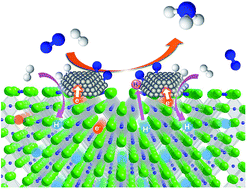The efficient reduction of atmospheric nitrogen to ammonia under low pressure and temperature conditions has been a challenge in meeting the rapidly increasing demand for fertilizers and hydrogen storage. Here, we report that Ca2N:e−, a two-dimensional electride, combined with ruthenium nanoparticles (Ru/Ca2N:e−) exhibits efficient and stable catalytic activity down to 200 °C. This catalytic performance is due to [Ca2N]+·e1−x−Hx− formed by a reversible reaction of an anionic electron with hydrogen (Ca2N:e− + xH ↔ [Ca2N]+·e1−x−Hx−) during ammonia synthesis. The simplest hydride, CaH2, with Ru also exhibits catalytic performance comparable to Ru/Ca2N:e−. The resultant electrons in these hydrides have a low work function of 2.3 eV, which facilitates the cleavage of N2 molecules. The smooth reversible exchangeability between anionic electrons and H− ions in hydrides at low temperatures suppresses hydrogen poisoning of the Ru surfaces. The present work demonstrates the high potential of metal hydrides as efficient promoters for low-temperature ammonia synthesis.
